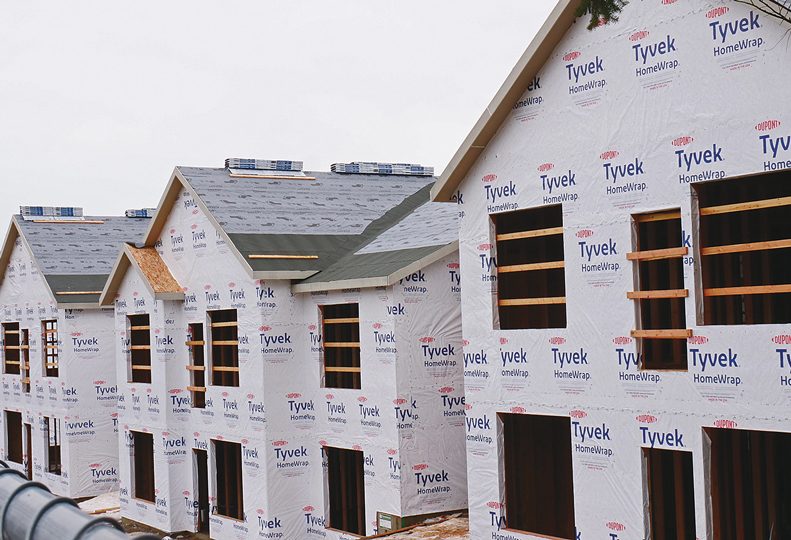
Home » Land capacity challenges Spokane County amidst growth pressures
Land capacity challenges Spokane County amidst growth pressures
Unincorporated urban growth areas lack sufficient space for projected population uptick

Spokane County is working to identify where the available buildable land within its boundaries is located to accommodate housing needs for an expected population increase of over 100,000 people in the next 20 years.
| Erica BullockFebruary 27, 2025
Over 53,000 additional dwelling units will be needed to house an additional 110,000 people in Spokane County over the next 20 years, Spokane County Building & Planning Department officials say as the Growth Management Act-inspired analysis takes shape.
Whether enough developable land is available within the urban boundary to accommodate that growth is still being determined.
Spokane County is grappling with land capacity issues as it works to accommodate the anticipated future population growth within its boundaries over the next 20 years.
The county's land capacity analysis is already underway as mandated by the Washington State Growth Management Act to determine the best way to meet the housing demand for an expected population uptick countywide by the year 2046, says Spokane County Planning Director Scott Chesney.
Graham Zickefoose, associate planner at Spokane County, told a Spokane County Growth Management Act Steering Committee meeting in late January, "The story that these numbers tell is that the unincorporated urban growth areas, which are the UGAs outside of any municipality, do not have enough capacity for our population allocation."
Spokane County Commissioner Josh Kerns says the Growth Management Act is a mandate passed by the state of Washington in the early 1990s. The GMA determines where density should occur across the state by requiring cities and counties to develop plans and regulations to manage future population growth as a way to control urban sprawl. The act requires jurisdictions to address 15 goals and issues such as housing, transportation, economic development, permits, natural resources, climate change and resiliency, and more.
Aspects of the Growth Management Act include establishing and updating urban growth boundaries where concentrated development is meant to increase density. Outside of an urban growth boundary, development is allowed only at much lower densities.
Preliminary housing and population growth estimates for unincorporated Spokane County show that over 17,000 housing units will be needed for 30,500 people. However, current capacity can only accommodate 10,800 housing units for about 24,000 people, Steering Committee data shows.
Preliminary land capacity analysis results show Spokane County has an estimated 1,057 acres of vacant land, 877 acres of partially used land, and 539 acres of platted land available to help meet future housing capacity, but determining where the available buildable land is located within Spokane County won't begin until later this year, says Chesney.
Kerns says the future land analysis will consider land topography, existing infrastructure, and landowner willingness to develop.
"It's difficult to say we have X number of acres so we can build X number of houses because there's so much more that goes into that," Kerns explains. "Are those acres on a hillside? Also, if there's no roads on these acres, when you put roads and sidewalks in, now you have less land to build on."
The population allocation for Spokane County comes from the Washington State Office of Financial Management's medium population projection, which was approved for use by Spokane County Commissioners Board last year, says Kerns.
Housing allocations are provided by the Washington State Department of Commerce's Housing for All Planning Tool, which establishes the number of housing units that jurisdictions must accommodate through zoning regulations across multiple affordability levels.
Some cities in Spokane County appear to have sufficient capacity to handle the allocated population growth, according to Spokane County data. Those include Fairfield, Latah, Liberty Lake, Millwood, Rockford, Spangle, Spokane, and Waverly.
Updates from individual jurisdictions include preliminary land capacity results for the city of Millwood, which has enough land within its boundaries to accommodate about 50 individuals that have been allocated to the city, according to information provided by city of Millwood Mayor Kevin Freeman to Spokane County's Steering Committee.
The city of Millwood also expects to change some residential housing codes to meet the need for 106 more housing units spread across all income levels, Freeman says.
At least two of the three residential zones in the city of Millwood will likely need to be updated to facilitate housing development, Freeman adds.
"The main issue ... is how Millwood is going to look at developing our requirements for permanent supportive housing and temporary emergency housing units," says Freeman, adding that the jurisdiction lacks the available infrastructure to reconcile the two to five temporary emergency housing units that will be needed.
In the city of Deer Park, it's likely the jurisdiction will exceed capacity for the 20-year population allocation of 1,300 people. The next step in the review process is to complete the city's housing analysis, according to information presented to the Steering Committee by Justin Baerlocher, senior analyst at J-U-B Engineers Inc., which is the company assisting with the comprehensive plan update for Deer Park.
The city of Spokane is planning to present its summary results to the Steering Committee in March, but preliminary data indicates that the city has more than enough capacity for the population and housing allocated by the state through 2046.
The city of Spokane's population is expected to grow by about 23,300 people over the next 20 years, and the city will need about 22,300 housing units to keep pace with the growing population, which is well below the city's preliminary future capacity results of 69,100 individuals and 33,100 dwelling units, county data shows.
Jurisdictions also are working to determine how to factor underutilized land into their plans, which is defined as land where the existing structure doesn't represent the densest possible use, according to the Steering Committee.
In unincorporated Spokane County, about 370 parcels were initially identified as land that meets the criteria to be considered underutilized land, however about 80% of those parcels are located within single-family subdivisions that are unlikely to change, Zickefoose explains.
"That left about 65 parcels remaining that could be considered underutilized," Zickefoose says, a figure too small to make a significant difference in housing planning.
A second round of housing allocations is expected to address population distribution in Spokane County for the next Steering Committee meeting, scheduled on March 20.
Public forums have been scheduled to gather input on neighborhood planning and development preferences from community members.
"We're going out to three separate areas of the county to talk about placemaking and resiliency," Chesney says.
On the West Plains, the county is interested in looking into how mostly flat and vacant land could be used for mixed-use development opportunities combining jobs and housing. In the Mead area, the focus will be on the efficient planning of infrastructure projects to coincide with urban development. In East Valley, the focus will address the creation of a neighborhood identity that discourages suburban subdivision sprawl, says Chesney.
After the analysis is complete, the county's final growth management plan could be adopted by the end of 2026, or by mid-2027 if an extension is granted by the Washington State Legislature, he says.
Overall, density is expected to increase within the urban growth areas, and development outside of the boundaries is expected to be less dense, says Kerns. Finding the right balance between accommodating growth and preserving the qualities that make Spokane County a desirable place to live is the central challenge, he says.
Latest News Real Estate & Construction Government
Related Articles
Related Products
Related Events





![Brad head shot[1] web](https://www.spokanejournal.com/ext/resources/2025/03/10/thumb/Brad-Head-Shot[1]_web.jpg?1741642753)